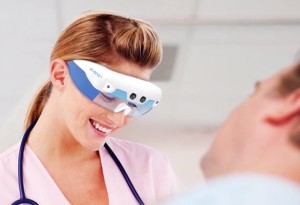Smartglasses could revolutionize to the workplace
 Smartglasses aren’t just for the tech nerds. There are many business scenarios that will benefit from smartglasses. The use of smartglasses has the potential to improve worker efficiency in vertical fields such as manufacturing, field service, retail and healthcare and more. Smartglasses, such as Google Glass, are causing companies to take a fresh look at the impact wearable electronics will have on the workplace. In this article I am going to discuss the use of smartglasses in the workplace.
Smartglasses aren’t just for the tech nerds. There are many business scenarios that will benefit from smartglasses. The use of smartglasses has the potential to improve worker efficiency in vertical fields such as manufacturing, field service, retail and healthcare and more. Smartglasses, such as Google Glass, are causing companies to take a fresh look at the impact wearable electronics will have on the workplace. In this article I am going to discuss the use of smartglasses in the workplace.
When you use a smartphone, you’re constantly switching between looking down at your display and up again into your environment. That can be very disruptive. Smartglasses with augmented reality (AR) and head-mounted cameras can increase the efficiency of technicians, engineers and other workers in field service, maintenance, healthcare and manufacturing roles. Studies have shown in the next three to five years, the industry that is likely to experience the greatest benefit from smartglasses is field service, potentially increasing profits by up to $1 billion annually. The greatest savings in field service will come from diagnosing and fixing problems more quickly and without needing to bring additional experts to remote sites. Smartglasses still remain an emerging technology in the enterprise and less than one percent of companies in the U.S. The introduction of lower-priced consumer versions of smartglasses will further help with the introduction of smartglasses in companies. According to recent studies in 10 years half the companies that would benefit from using smartglasses will give them to at least some of their employees who could make use of them.
Adoption of smartglasses will be slow because the benefits they provide depend heavily on the apps and services targeted at smartglasses. However, during the next five years, the ecosystems will evolve to include more apps that do specific tasks with smartglasses, which may cause IT organizations to provide them for a wider range of employees.
Smartglasses are expected to have the most impact on heavy industry, such as manufacturing, and oil and gas, because the AR glasses enable on-the-job training of workers in how to fix equipment and perform manufacturing tasks. The impact is likely to be medium for mixed industries, such as retail, consumer packaged goods and healthcare, where the benefits may mostly be looking for information via a visual search.
The weightless industries, such as insurance, media and banking will likely experience a low impact from smartglasses. However, there are still potentially beneficial uses for smartglasses. Insurance agents, for example, may use smartglasses to video property that has been damaged and then check on the replacement value of items they have identified using a visual search. Financial institutions and the media will use smartglasses to deliver alerts via subscription services for smartglasses to professionals who need up-to-the-minute information.
Experts expect that some of the basic functions of smartglasses to help bring added efficiency to companies. How-to instructions and illustrations on the smartglass displays enable workers to perform tasks even if they do not remember all the procedures. The virtual assistant on the smartglasses could serve as an interactive, hands-free “how-to” manual. As a result, workers may successfully complete tasks they have little experience doing. Workers with mild memory issues or cognitive impairment may find smartglasses useful tools for remembering how to complete tasks.
Video collaboration with experts in remote locations will result in faster repairs and will save the expense of flying an expert to the site to help. Employees at remote sites can communicate and share video of what they see with experienced workers to get advice on how to diagnose and fix problems. In this way, companies can improve the cost-effectiveness of their field service and remote operations by employing a larger percentage of less-experienced workers to experienced ones or specialists, in result saving labor costs.
Companies are already asking their IT organizations to make recommendations about whether smartglasses should be used in the workplace based on benefits and risks perspective, as well as policy and implementation. Though IT organization could possibly provide smartglasses to employees in the future for job tasks, the biggest impact may come from employees who wear their personal smartglasses at work. Overall, if a company were to wait to release smartglass into the workplace today they may not regret it but as shown they might be missing out on the latest way to save money.

